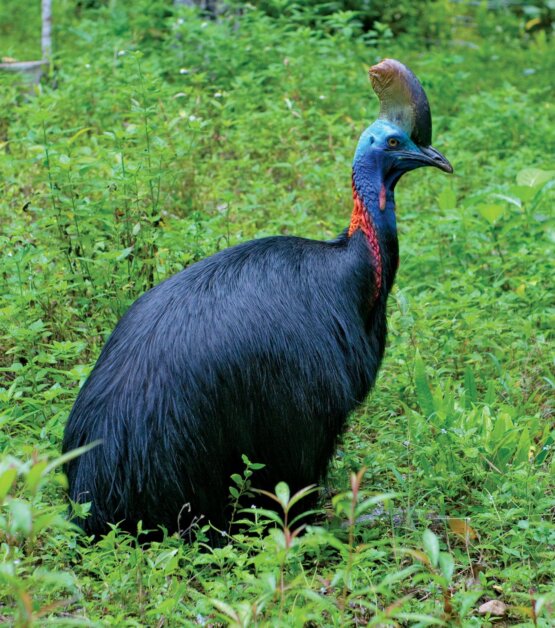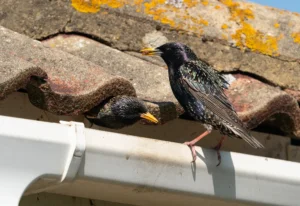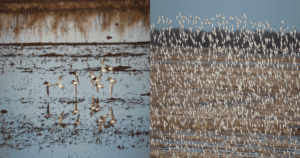World’S Most Dangerous Birds: Fearsome Feathered Predators
Birds are often seen as beautiful and harmless creatures. But some birds can be surprisingly dangerous.
Welcome to the wild world of avian predators. In this blog post, we will explore the world’s most dangerous birds. These feathered foes are not just about sharp beaks and talons. Some possess powerful kicks, toxic feathers, or aggressive behaviors.
Whether they live in remote jungles or near human habitats, these birds can pose serious threats. Understanding their nature can help us appreciate their role in the ecosystem and stay safe. So, let’s dive into this fascinating yet perilous part of the bird kingdom. Get ready to meet some of the most formidable feathered creatures on the planet.
Introduction To Dangerous Birds
Birds can be beautiful and fascinating creatures. Yet, some birds can be dangerous. They possess traits that can harm humans. These dangerous birds are not just a threat to people. They can also pose risks to other animals. Understanding these birds is important for our safety.
Birds As Predators
Some birds are natural predators. They have sharp beaks and strong talons. These features help them hunt their prey. Birds like eagles and hawks are known for their hunting skills. They can swoop down and catch animals in a matter of seconds. These predators are powerful and swift. They play a key role in the ecosystem.
Other birds use their size to intimidate. Birds like the cassowary can be very aggressive. They can cause serious injuries with their strong legs and sharp claws. Their size and strength make them dangerous. These birds can be a real threat if provoked.
Why Study Dangerous Birds
Studying dangerous birds helps us understand their behavior. It also helps us know how to stay safe around them. Learning about these birds can prevent accidents. It can also help us protect our pets and livestock. Knowing their habits and habitats is crucial.
Research on dangerous birds can also help in conservation efforts. Many of these birds are endangered. Understanding their needs can help us protect them. It ensures a balance in our ecosystem. Their role as predators keeps the population of other species in check.
Overall, knowing about dangerous birds is vital. It helps us coexist with these powerful creatures. It also helps us appreciate their role in nature.
Cassowary: The Lethal Striker
The cassowary is often called the world’s most dangerous bird. Known for its powerful legs and sharp claws, this bird can cause serious harm. Its aggressive nature and striking speed make it a true danger in the wild. Let’s delve into the fascinating aspects of this lethal striker.
Habitat And Range
The cassowary lives in the tropical forests of New Guinea, northern Australia, and nearby islands. These birds prefer dense forested areas where they can find ample food and shelter. They are mainly found in rainforests, swamps, and mangroves.
They thrive in regions with high humidity and thick vegetation. The cassowary’s habitat is crucial for its survival, providing both food and protection from predators.
Physical Characteristics
| Feature | Description |
|---|---|
| Size | Up to 6 feet tall |
| Weight | Up to 130 pounds |
| Color | Black feathers with bright blue and red neck |
| Claws | Sharp, dagger-like middle claw |
Cassowaries have a unique casque on their head, which is a helmet-like structure. This casque helps them move through dense forest and is also used for display during mating. Their strong legs are built for running and striking, making them efficient hunters and dangerous opponents.
Dangerous Encounters
- Cassowaries are known to attack when threatened or provoked.
- They use their powerful legs to kick and their sharp claws to strike.
- Encounters with humans can be deadly due to their aggressive defense tactics.
There have been reports of cassowaries causing severe injuries and even fatalities. Their speed and strength make them formidable adversaries. It is advised to keep a safe distance and respect their space in the wild.
The cassowary’s aggressive behavior is a defense mechanism to protect itself and its territory. Understanding their nature helps in preventing dangerous encounters.
Southern Ostrich: The Aggressive Giant
The Southern Ostrich is one of the world’s largest and most aggressive birds. Known for its towering height and powerful legs, this bird can be a formidable opponent. Let’s delve into the behavior, defensive mechanisms, and interactions with humans of this fascinating giant.
Behavior And Temperament
Southern Ostriches are known for their territorial behavior. They can be very aggressive, especially during the breeding season. Males defend their territory fiercely and will chase away any intruders. These birds are generally more aggressive than their northern cousins.
Despite their aggression, they can also display unique social behaviors. They live in groups, which helps them protect each other from predators. Their pecking order within the group is strict, and lower-ranking birds must always be on alert.
Defensive Mechanisms
One of the primary defensive mechanisms of the Southern Ostrich is its powerful legs. They can run at speeds of up to 70 km/h (43 mph), making escape a viable option. If cornered, they can deliver a powerful kick capable of causing serious injury.
Their sharp claws are another defense tool. These claws can rip through flesh, deterring most predators. In addition, their large size and loud hissing sounds can intimidate potential threats.
Human Interactions
Interactions between humans and Southern Ostriches can be dangerous. Farmers often face challenges when these birds invade their land. They can destroy crops and pose a threat to livestock.
There have been instances where these birds have attacked people. This usually happens when they feel threatened or are protecting their young. It is important for people to keep a safe distance and avoid provoking them.
Despite their aggression, Southern Ostriches are also farmed for their feathers, meat, and skin. This has led to some level of domestication, although they retain much of their wild temper.

Credit: www.nytimes.com
Harpy Eagle: The Powerful Hunter
The Harpy Eagle is a true apex predator. Found in tropical rainforests, it commands respect. This bird is one of the largest and strongest eagles. Its name comes from the harpies of Greek mythology. These mythical creatures were known for their power and ferocity.
Hunting Techniques
Harpy Eagles use stealth and surprise to hunt. They perch silently, waiting for the right moment. With powerful talons, they can snatch prey from trees. Their strong legs and sharp claws make them efficient killers. They can carry prey weighing up to their own body weight.
Prey And Diet
The Harpy Eagle has a varied diet. They mainly feed on tree-dwelling animals. Monkeys and sloths are their favorite meals. Sometimes, they also eat birds, reptiles, and small mammals. Their powerful beaks and claws help them tear through tough hides.
Conservation Status
The Harpy Eagle faces threats in the wild. Deforestation reduces their natural habitat. This makes it hard for them to find food and shelter. They are also hunted by humans. These factors have led to a decline in their population. Conservation efforts are underway to protect these majestic birds. Laws and breeding programs help, but more work is needed.
Great Horned Owl: The Silent Killer
The Great Horned Owl is one of the most formidable predators in the bird world. Known for its stealth and power, this bird of prey is rightly called the “Silent Killer.” With its keen senses and deadly hunting skills, it rules the night skies.
Nocturnal Habits
The Great Horned Owl is primarily nocturnal. This means it is most active at night. Its large eyes and excellent night vision give it an edge in the dark. The owl’s hearing is also exceptional, allowing it to locate prey even in complete darkness. During the day, it rests in quiet, sheltered areas, blending in with its surroundings.
Hunting And Prey
Great Horned Owls are opportunistic hunters. They prey on a wide variety of animals. Their diet includes:
- Small mammals like mice and rabbits
- Birds, including other owls
- Reptiles and amphibians
- Insects and fish
The owl uses its sharp talons to catch and kill its prey. It can crush bones with its strong grip. The element of surprise is its best weapon. The owl’s feathers are specially designed for silent flight. This allows it to swoop down on prey without being heard.
Human Conflicts
Great Horned Owls occasionally come into conflict with humans. They may attack pets or livestock, especially if food is scarce. These incidents are rare but can be serious. Farmers sometimes view them as pests. On the other hand, they help control rodent populations, which benefits agriculture.
In some cultures, the owl is seen as a symbol of wisdom. In others, it is viewed with fear. Despite their fearsome reputation, these owls play a crucial role in their ecosystems.
Respect and understanding can help reduce conflicts. By learning more about these majestic birds, we can coexist peacefully.
Red-tailed Hawk: The Agile Predator
The Red-Tailed Hawk is one of the most formidable birds of prey. Known for its agility and keen hunting skills, this bird is a true master of the skies. Its sharp talons and keen eyesight make it a dangerous predator. Let’s explore what makes the Red-Tailed Hawk such an agile predator.
Flight And Hunting Skills
The Red-Tailed Hawk is an expert flier. Its wingspan can reach up to four feet, allowing it to soar high and glide effortlessly. During flight, it can spot prey from great distances. With a speed of up to 120 mph during a dive, it is a swift hunter.
Its hunting technique involves soaring and hovering to locate prey. Once spotted, it dives swiftly, using its sharp talons to capture the target. This method ensures that the prey has little chance to escape.
Prey Selection
The diet of the Red-Tailed Hawk is diverse. It primarily hunts small mammals such as mice, rabbits, and squirrels. Birds and reptiles are also part of its diet.
| Type of Prey | Examples |
|---|---|
| Mammals | Mice, Rabbits, Squirrels |
| Birds | Sparrows, Doves |
| Reptiles | Snakes, Lizards |
The hawk’s diet varies with the seasons and availability of prey.
Urban Encounters
Red-Tailed Hawks are increasingly seen in urban areas. They adapt well to city life, often nesting on tall buildings. Urban environments offer abundant food sources, such as pigeons and rats.
These encounters can be fascinating yet dangerous. The hawk’s hunting instincts remain sharp, making it a threat to small pets.
To ensure safety, keep small pets indoors and avoid direct interaction with these wild birds. Admire them from a distance and respect their space.
Golden Eagle: The Majestic Raptor
The Golden Eagle, known for its power and grace, reigns as one of the most formidable birds of prey. Its striking golden-brown feathers and piercing eyes make it a symbol of strength and freedom. These birds are not just beautiful; they are also skilled hunters.
Range And Habitat
Golden Eagles inhabit vast regions across North America, Europe, and Asia. They prefer open and semi-open areas like mountains and grasslands. These eagles build their nests on high cliffs or in tall trees, offering a wide view of their territory.
Hunting Strategies
Golden Eagles are expert hunters. They use their keen vision to spot prey from great distances. Once they locate their target, they dive at high speeds. Their sharp talons are capable of capturing and killing even large animals. These eagles often hunt mammals like rabbits and foxes. They can also take down birds and reptiles.
Role In Ecosystem
Golden Eagles play a crucial role in their ecosystems. They help control populations of small mammals and birds. This keeps the balance in their habitats. By removing weak or sick animals, they promote the health of prey populations. Their presence indicates a healthy environment. Protecting these eagles helps preserve biodiversity.

Credit: www.moneycontrol.com
African Crowned Eagle: The Stealthy Assassin
African Crowned Eagle, known as the stealthy assassin, is among the world’s most dangerous birds. Its powerful talons and keen hunting skills make it a formidable predator.
Camouflage And Ambush
The African Crowned Eagle uses camouflage to blend into its surroundings. It patiently waits to ambush unsuspecting prey.Prey And Hunting Grounds
This stealthy assassin preys on monkeys, antelopes, and even baboons. It hunts in dense forests and open savannas.Conservation Challenges
Deforestation threatens the eagle’s habitat. Poaching and illegal trade further endanger this majestic bird.
Credit: www.britannica.com
Frequently Asked Questions
What Is The Most Dangerous Bird?
The cassowary is often considered the world’s most dangerous bird. It has powerful legs and sharp claws that can cause serious injuries.
Can Ostriches Be Dangerous To Humans?
Yes, ostriches can be dangerous. They can run fast and deliver powerful kicks. Their kicks can cause severe injuries.
Why Are Emus Considered Dangerous?
Emus can be dangerous due to their strong legs and sharp claws. They can inflict serious injuries if threatened.
Are Harpy Eagles Dangerous To Humans?
Harpy eagles are not typically dangerous to humans. However, their powerful talons can be harmful if they feel threatened.
Conclusion
Dangerous birds captivate and terrify. They remind us of nature’s power. Each bird has unique traits that make it formidable. From the mighty cassowary to the fierce harpy eagle, these birds command respect. Understanding them helps us appreciate wildlife more.
Stay informed and stay safe. Birds can be beautiful and deadly. Respect their space and observe from a distance. Fascination with dangerous birds teaches us caution and awe. Nature’s wonders never cease to amaze.
Hello Dear, I'm Poli Kolymnia, owner of many birds (including budgies).
With a deep passion for these feathered companions, I'm here to share my expertise and extensive knowledge on birds care.
My articles cover essential topics like diet, housing, care, and health, providing practical tips to help you create a happy and thriving environment for your birds.





